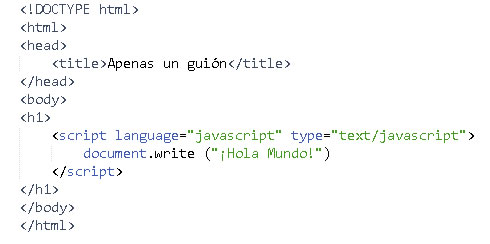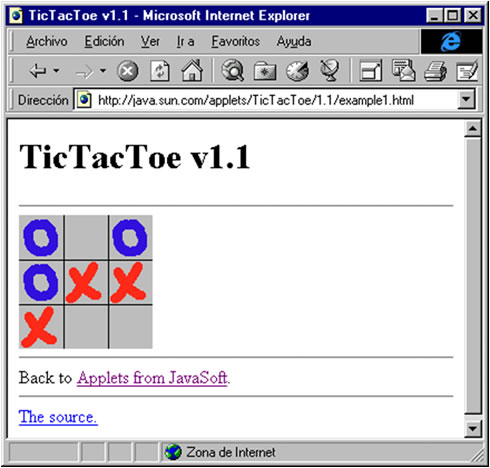What is JavaScript - Origin, evolution and features
Netscape invented JavaScript to make any Web page dynamic and interactive. Because HTML did not have enough features.

For the creators of Web sites, the evolution of HTML has been a blessing not without controversy.
In the early days of the World Wide Web, HTML was quite simple, and quite easy to learn almost everything you needed to know to group web pages.
At the beginning of the 90s, the majority of users who connected to the Internet did so with modems at a maximum speed of 28.8 kbps. At that time, the first web applications began to develop and, therefore, web pages began to include complex forms.
With increasingly complex web applications and a slow browsing speed, the need arose for a programming language to be executed in the user's browser.
In this way, if the user did not fill in a form correctly, they did not wait for a long time until the server returned to show the form indicating the existing errors.
As the Web grows, the aspirations of the designers also grow, and their demand for more control over the page forced HTML to change and become more complex.
The Web is a dynamic medium, the designers also wanted their pages to interact with the user, and it soon became clear that HTML was insufficient to meet this demand.
Brendan Eich, a programmer who worked at Netscape, thought he could solve this problem by adapting other existing technologies (such as ScriptEase) to the Netscape Navigator 2.0 browser, which was to be launched in 1995.
Initially, Eich called his language LiveScript.
Subsequently, Netscape signed an alliance with Sun Microsystems for the development of the new programming language. Also, just before launch Netscape decided to change the name to JavaScript.
The reason for the name change was exclusively marketing, since Java was the buzzword in the computer and Internet world of the time.
The first version of JavaScript was a complete success and Netscape Navigator 3.0 already incorporated the next version of the language, version 1.1
At the same time, Microsoft launched JScript with its Internet Explorer 3 browser. JScript was a JavaScript copy that was renamed to avoid legal problems.
To avoid a war of technologies, Netscape decided that it would be best to standardize the JavaScript language.
In this way, in 1997 the JavaScript 1.1 specification was sent to ECMA (European Computer Manufacturers Association).
This is how Netscape invents JavaScript in order to control the browser and add dynamism and interactivity to Web pages.
Since its creation JavaScript has evolved a lot (although sometimes in different directions, depending on the browser).
What is JavaScript?
JavaScript is a programming language that can be used to add interactivity to Web pages.
JavaScript is often called "script writing language" (scripting language) denoting that it is easier to write scripts than to program. In this case, it is a distinction without distinction.
A Script Script is a program that is contained internally within an HTML page (which is the original method of writing scripts) or resides in an external file (the currently preferred method).
In HTML pages, as it is included in the <script> script tag, the script text does not appear on the user's screen, and the web browser is the one that executes the JavaScript program.
The <script> tag is often found within the <head> section of the HTML page, but you can also include hyphens, if desired, in the <body> section.
The internal scripts that write text on the screen, or write HTML, it is preferable to insert them in the section <body> as in the script shown below:

This simple script shows the message "Hello World!" in the browser window
JavaScript is not Java
Despite the name, Javascript and Java have almost nothing to do with each other.
Java is a full-featured programming language, developed and marketed by Sun Microsystems.
With Java, a descendant of the C and C ++ programming languages, programmers can create entire applications and control the user's electronic devices.
Unlike other languages, Java keeps the promise of compatibility between different platforms (cross platform), which means that a programmer could write a Java program that runs on any kind of computer, whether you run this Windows, Mac OS X or any of the different versions of Unix.
In practice, Java has not completed that dream, due in large part to disputes between Sun and Microsoft regarding language direction.
First of all, Microsoft became involved because it wanted to integrate Java into Windows in its own way (a way that Sun says would make Java work in a way in Windows and otherwise in other computers, thereby failing to fulfill the primary purpose of Java ); later, Microsoft introduced Java for Windows, once it created its own Java-style language, C #.
After a lot of litigation between the two companies (and a big deal in favor of Sun), Microsoft eliminated its Windows Java and, now, the user can install the latest Java version of Sun for Windows (or Linux) from your official page. Mac OS X has Java installed as part of the operating system.
In addition to the independent applications, the main use of Java on the client side, that is, on the user's browser, is the creation of applets, small programs that are downloaded on the Internet and run on Web browsers.
Due to the cross-platform nature of Java, these applets should also run on any browser that supports Java.
In recent years, many Java applets have been replaced by Macromedia Flash animations, which are usually easier to create than Java applets.
Today, Flash is slowly being replaced by the new possibilities offered by HTML5 along with CSS3 and Jquery.
The applets are embedded in the Web pages using the HTML <object> tag, with additional information specified by the Java applet of the server and executed in the screen area specified in the tag.

This Java applet plays a game of traditional cat
The origin of JavaScript
If JavaScript has nothing to do with Java, then why do they have similar names?
It is another example of one of the most annoying particularities of the computer industry: the triumph of marketing over substance.
When Netscape added some basic scriptwriting possibilities to its Navigator navigator, it named this scripting language as LiveScript. Around the same time, Java was getting a lot of press as the "Next big thing in computing".
When Netscape revised Navigator to run Java applets in Navigator 2, LiveScript was renamed JavaScript, hoping to file some of the Java brilliance.
The mere fact that JavaScript and Java are very different programming languages did not stop the marketing geniuses of Netscape.
When Microsoft saw that JavaScript was gaining popularity among Web developers, it realized that it had to add certain scripting capabilities to Internet Explorer.
They could have adopted JavaScript, but as usual, Microsoft chose to develop its own language, which works much like JavaScript, but which is not exactly the same.
The JavaScript version developed by Microsoft is called JScript.
What JavaScript can do
With JavaScript, you can do many things to make your web pages more interactive and provide a more interesting experience to visitors to your site.
JavaScript allows you to create an active user interface, which offers feedback to visitors as they browse their pages.
You can use JavaScript to make sure that users enter valid information in the forms, which will result in savings in time.
If your forms require calculations, you can perform them with JavaScript on the user's computer, without having to perform server-side processes.
There is a distinction that must be recognized: the programs that run on the user's computer are known as client-side programs; the programs that run on the server are known as server-side programs.
With JavaScript, you can create personalized HTML pages on the fly, depending on the actions executed by the user. Suppose you are in a travel site and the user clicks on Hawaii as a destination.
You can make the latest Hawaii travel deals appear in a new window. JavaScript controls the browser, so you can open new windows, view alert windows and insert personalized messages in the status bar of the browser window.
Because JavaScript has a set of date and time functions, you can generate documents with clocks and time clocks.
You can also take care of forms, set cookies, build HTML pages on the fly and create web-based applications.
What JavaScript cannot do
JavaScript is a client language; that is, it is designed to perform your work on your computer (yours), not on the server. Therefore, JavaScript suffers some inherent limitations, most of them for security reasons.
- JavaScript does not allow reading or writing files on client machines. To a large extent, that's good, because you probably would not want a Web page to be able to read the files on your hard drive, or be able to write viruses on your disk or be able to manipulate the files on your computer. The only exception is that Javascript can write in the browser cookie file, but even this feature has its limitations
- Javascript does not allow writing files on server machines. There are several ways to do this (such as storing impact counters on the page or filling in data forms), but JavaScript is not allowed to do these things. Instead, you will need to have a program on your server to manipulate and store this data. For example, it may be a CGI written in a language such as Perl or PHP
- Javascript can not close a window that it has not opened. This is to avoid a site taking control of your browser and start closing windows from other sites
- JavaScript can not read information from an open Web page from another server
CITE ARTICLE
For homework, research, thesis, books, magazines, blogs or academic articles
APA Format Reference:
Delgado, Hugo. (2019).
What is JavaScript - Origin, evolution and features.
Retrieved Nov 18, 2025, from
https://disenowebakus.net/en/javascript







Felicitar al profesor! de extrema calidad su trabajo. saludos desde Montevideo
Me encanta esta pagina, explica todo de forma muy entendible sin tanto lenguaje tecnico que puede llegar a confundir a los novatos
Para los creadores de sitios Web, la evolución de HTML ha sido una bendición no exenta de controversia.